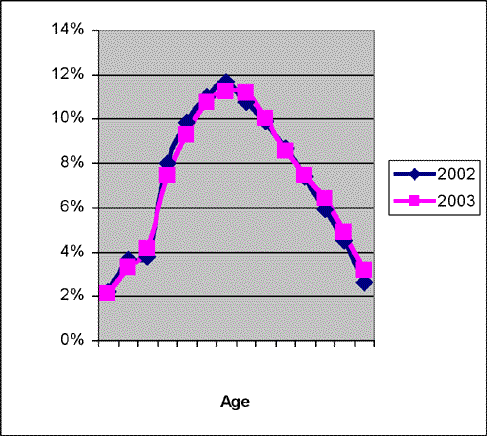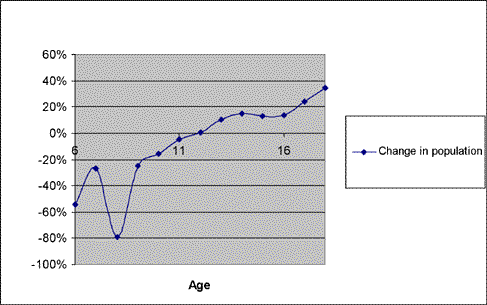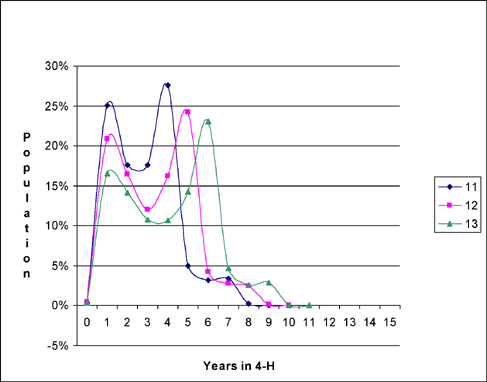October 2005 // Volume 43 // Number 5 // Research in Brief // 5RIB4
An In-Depth Look at 4-H Enrollment and Retention
Abstract
The membership of 4-H is a highly fluctuating,
variable body, with youth coming and going at all ages. A more complete understanding
of this fluctuation can be obtained by examining enrollment and retention
trends, allowing agents to identify key strategies to increase membership
in their own counties. By using the ES 237 data for Colorado from 2002 and
2003, it was possible to recognize patterns that have implications for the
ways agents handle recruitment. Increasing retention in 4-H is most closely
linked to enrolling youth at an early age and preventing the loss of first
year members.
Introduction
Here today, gone tomorrow--does this describe 4-H enrollment in your county? For many years, 4-H has struggled with the complex problems of membership recruitment and retention, especially with older youth.
In 1983, a study was conducted in West Virginia to determine the re-enrollment and dropout rates for first year 4-H club members, as well as factors affecting re-enrollment. Findings included that members who participated in 4-H activities more often had a higher rate of re-enrollment, as did members with supportive parents. Approximately 45% of new members became dropouts after the first year. In general, the older 4-H members were when they first enrolled in the program, the less likely they were to continue (Hartley, 1983).
Soon after the West Virginia study, agents in southeast Kansas found in their research that 40-50% of members were dropping after their first year, and an additional 20% dropped after the second year. A survey of first-year families indicated a lack of understanding of the 4-H program, never feeling welcome or part of the group, and conflicting time commitments were major contributors to the decision to drop 4-H (Astroth, 1985).
In 1991, Extension personnel in Louisiana again examined the puzzling issue of 4-H retention (Acosta & Holt, 1991). A needs assessment conducted by one rural parish in the state asked teens in seventh through twelfth grades to identify topics that they wanted to have more information about. By incorporating the topics of highest interests into their programming--careers, suicide, pregnancy, dating, teen years, fashion, and after high school--the parish saw a 21% increase in the senior retention rate after 2 years (Acosta & Holt, 1991).
While Louisiana was looking at ways to retain youth in their programs, Indiana was attempting to identify reasons why the program failed to address the needs of some youth. By conducting phone interviews with older youth (10-18 years of age) who had dropped out of 4-H, the researchers were able to isolate the single most frequent reason given for dropping 4-H: displeasure with 4-H clubs. The competing time demands of sports and jobs were also ranked highly by 4-H dropouts as reasons for leaving the program (Ritchie & Resler, 1993).
Today, Extension agents still recognize the findings from these studies as issues affecting retention rates in their own counties. Despite positive growth in overall 4-H participation in the last several years, membership in organized clubs has remained nearly static. In 1996, there were 6.30 million youth participating in 4-H; of those, 1.54 million were enrolled in 4-H clubs. In 2003, 7.0 million youth experienced some form of 4-H, but only 1.57 million of those youth were club members (National 4-H Enrollment Report, 2004).
A recent analysis of Colorado's ES 237 data offers some insight into understanding trends in traditional 4-H enrollment and retention in the twenty-first century. ES 237 data is gathered in each county and state annually and includes demographic information for all youth and leaders involved in the 4-H program. This information includes age, years in 4-H, ethnicity, and race. A thorough review of the findings resulted in the identification of several strategies to increase recruitment and retention of 4-H members.
Methods
The ES 237 data for Colorado from 2002 and 2003 was analyzed in an effort to more thoroughly understand 4-H enrollment and retention. The analysis was based upon a traditional club membership of 11,518 and 17,331 net records for 2002 and 2003, respectively. Duplicate records, incomplete data, and invalid ages were removed from the gross total membership reported for those years to arrive at the net totals.
Findings
The major findings from the analysis of ES 237 data are most easily understood in the context of four graphs: 4-H Member Population by Age, Estimated Net Dropout Rate by Age, Years in 4-H by Age—Intermediate Members, and Years in 4-H by Age—Senior Members (Figures 1-4).
4-H Member Population by Age
Figure 1.
4-H Member Population by
Age

In Figure 1, members who were 11 years of age comprised the largest percentage of the 4-H population. The distribution of ages is suggestive of a bell curve, with the smallest percentages of the 4-H population occurring at ages 5-7 and 16-18.
Estimated Net Dropout Rate by Age
Figure 2.
Estimated Net Dropout Rate
by Age

To determine the estimated net dropout rate by age, the number of members at each age was compared with the number of members at the age one year ahead. The ES 237 data from 2003 was used in these calculations.

This is not a direct value for the dropout rate, but serves as a model to determine what the dropout rate would be if conditions did not change. It also assumes that the individuals in the 2002 and 2003 data behaved the same. This is considered to be a good assumption due to the close match in population distribution for both years, but may not hold true for longer spans of time.
Negative percentages in Figure 2 indicate growth in the population, while positive percentages show that members are dropping out. 4-H had a negative net dropout rate for members 6-11, indicating more children enrolled in 4-H than left the program at those ages. At age 12, the net dropout rate crossed through zero (a static population) and never dropped below it again. From age 13 through age 18, 4-H increasingly lost more members than it recruited.
Years in 4-H by Age
In order to identify peak periods of enrollment as well as retention trends, the percentage of the population reporting "x" years in 4-H was plotted for each age group. An age group is defined as all the members reporting the same 4-H age. For purposes of simplicity, the graphs were separated into intermediate membership (Figure 3) and senior membership (Figure 4). The decision was made to exclude the junior membership because extrapolations about junior enrollment may be made from the intermediate and senior data.
Figure 3.
Years in 4-H by Age--Intermediate
Membership

Figure 3 identifies several major enrollment trends in the intermediate membership (ages 11-13).
-
A significant portion of each age group was comprised of first year members. It is worth noting that age group 11 had more first year members than the other groups. Those declined by approximately 5% for age group 12 and an additional 5% for age group 13.
-
Valleys in the graph occurred for each age group after the first year, bottoming out at the second, third, and fourth years respective to age groups 11, 12, and 13.
- The population peaks for each group
were as follows:
- Age group 11 – 4 years in 4-H
- Age group 12 – 5 years in 4-H
- Age group 13 – 6 years in 4-H
-
After the population peak, the population percentages dropped dramatically for each age group.
Figure 4.
Years in 4-H by Age--Senior
Membership

Similar to Figure 3, Figure 4 also identifies enrollment trends, as well as retention trends. They are as follows/
-
First year members were the smallest part of the population for age group 18.
-
There was a small drop in the second year of membership for all groups except age group 18. Membership then remained relatively stable until a sharp increase to the population peak.
- The population peaks for each group
were as follows:
- Age group 14 – 7 years in 4-H
- Age group 15 – 8 years in 4-H
- Age group 16 – 9 years in 4-H
- Age group 17 – 10 years in 4-H
- Age group 18 – 11 years in 4-H
-
The population peak for each age group coincided with youth enrolling at age 7.
-
After the population peak, the percentages dropped dramatically for each group.
Discussion
4-H Member Population by Age (Figure 1)
Although only 2 years of data were examined in this research, the nearly identical nature of the 4-H Member Population by Age for both 2002 and 2003 suggests that this pattern may extend to the years surrounding it. The steady increase in member population until age 11 implies a strong interest in 4-H.
It has previously been noted that "at any given time, participation in 4-H, Scouts, and other youth organizations is skewed with 9 to 11 year olds comprising over half of the participants" (Heinsohn & Lewis, 1995). The interests of the parents may also factor into the high rates of enrollment seen from ages 8 – 11. Heinsohn & Lewis (1995) also note that for younger children, "parents move their children into group experiences€[and] determine the experiences and activities their children will have." High enrollment may also be indicative of recruiting efforts aimed at these ages.
A large jump in population occurs between the ages of 7 and 8, nearly doubling the number of members. Possibly, this can be accredited to the difference in opportunities offered to these age groups. In Colorado, youth may join 4-H as Cloverbuds between the ages of 5-7. Cloverbuds may join a club, but with limited participation--including no competitive events. It appears that many parents enroll their children when they can become members of Colorado's traditional program and not before then. This may be related to a desire to have their children compete, misconceptions about the Cloverbud program, or inadequate publicity for Cloverbuds.
Conversely, one observes that the steady decline in the member population begins at age 12 and continues on through age 18. This decline supports the perceptions by 4-H agents that senior members are difficult to retain in the program.
It has been suggested that the loss of senior members is not a poor reflection on 4-H, but rather a part of the natural development of adolescents. Unlike younger youth, adolescents are given more autonomy in choosing their activities and often opt to leave a program chosen by their parents in favor of one of their own choosing. Additionally, adolescence is commonly associated with exploration and experimentation, as well as a time to commit to refining specific interests and strengths (Heinsohn & Lewis, 1995). Continued involvement in 4-H may prevent an adolescent from having the desired time to explore new activities and contribute to an individual's decision to leave the program.
Estimated Net Dropout Rate by Age (Figure 2)
The Estimated Net Dropout Rate by Age reflects the patterns found in the 4-H Member Population by Age with one notable exception. In Figure 1, there is a steady increase in the member population through age 12. While Figure 2 does show a negative dropout rate for those ages, there is no consistency in the numbers. At age 6, the dropout rate is –54%, but that rate increases to –27% at age 7 and then decreases again to –79% at age 8. While the decrease from ages 7-8 has already been discussed and ties in with the large boost in enrollment at age 8, it remains unclear why the dropout rate does not consistently decline from ages 6-8, when the population is clearly rising. Certainly, 4-H in Colorado is not maintaining the same success in recruiting youth at age 7 as it is at ages 6 or 8.
Years in 4-H by Age (Figures 3 and 4)
Perhaps the most comprehensive view of enrollment and retention is obtained from Figures 3 and 4. Many parallel observations exist between the two graphs.
-
Older youth are less likely to join 4-H. This trend culminates with youth aged 18, with less than 5% of this group enrolling as new members.
-
There are less second year members in each age group than there are first year members. This pattern is supported by Astroth's (1985) and Hartley's (1983) studies that noted high percentages of first year families dropping the program.
-
For every age group, the population peak occurred according to the following formula: Age – Years in 4-H = 7. In other words, the majority of members at every age had enrolled in 4-H at age 7. However, more youth enroll at age 8 than any other age.
Clearly, 4-H is struggling to meet the needs of older youth. Not only do the data show that it is difficult to attract older members, there is a challenge in retaining them. However, many members who joined at an early age continue to re-enroll each year as they grow older. Identifying the reasons long-term members choose to continue with 4-H is a critical piece in understanding the puzzle of serving older youth.
Recommendations
Agents who are looking to improve their 4-H recruitment and retention efforts should consider the following recommendations.
Recruitment
-
To more evenly balance the 4-H population, strengthen recruitment efforts for audiences 12-18 years old. Working with the school districts to distribute 4-H information, holding an open house, or targeting advertising towards places teens often gather are all options.
-
In this research, enrolling at an early age in 4-H was related to an increased likelihood of remaining in 4-H as a senior member. To build a larger population of long-term members, increase parental awareness of the benefits of joining 4-H as a Cloverbud (ages 5-7). Opportunities to explore new activities and have group experiences in a safe environment are examples of benefits.
-
Agents commonly recognize that current members are the most effective recruiters for 4-H. Provide Clover memorabilia and promotional items to current members to share with their friends, have in their houses or on their cars.
Retention
-
Implement a new-family mentoring system to support first-year members. Previous research has shown this to be a positive step in preventing the high rate of dropouts that occurs between the first and second years (Astroth, 1985).
-
Conduct a needs assessment (similar to the one done in Louisiana) for the intermediate and senior levels of membership to modify and develop programs matching these groups' interests and desires.
-
Increase flexibility in the structure of the club program to allow older youth to explore outside interests while maintaining membership in 4-H.
-
Future research should examine the effects that joining 4-H as a Cloverbud (ages 5 to 7) has on retention.
References
Acosta, D. T.. & Holt, B. A. (1991). Give teens the programs they want . . . and need. Journal of Extension [On-line], 29(1). Available at: http://www.joe.org/joe/1991spring/a8.html
Astroth, K. A. (1985). The challenge of retaining 4-H members, Journal of Extension [On-line], 23(3). Available at: http://www.joe.org/joe/1985fall/sa4.html
Hartley, R. S. (1983). Keeping 4-H members. Journal of Extension
[On-line], 21(4). Available at: http://www.joe.org/joe/1983july/a4.html
Heinsohn, A. L. (1995). Why do teens drop out?: A developmental view. Journal of Extension [On-line], 33(1). Available at: http://www.joe.org/joe/1995february/comm1.html
National 4-H Enrollment Report (2004). United States Department of Agriculture. Available at: http://www.reeis.usda.gov
Ritchie, R. M., & Kenda M. Resler, K. M. (1993). Why youth drop out of 4-H. Journal of Extension [On-line], 31(1). Available at: http://www.joe.org/joe/1993spring/rb3.html
